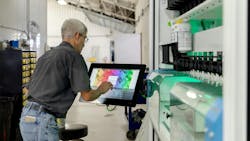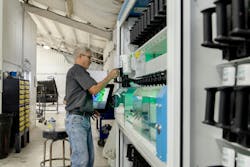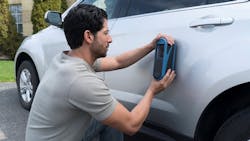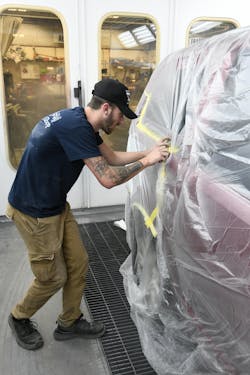Financial Series: Optimizing Paint and Material and Sublet Gross Profit
Having run hundreds of performance groups over the past 40 years, FenderBender challenged me to recap the key learnings on the main topics the groups discuss. This is the third part of the series.
Opportunity: Optimizing P and M Gross Profit
This article will share processes implemented by the performance group members who achieve the highest paint and material gross profit percentage. Paint and Material represents anywhere from 7.8-9.8% of various shops' sales mix, and depending upon their circumstances, shops can expect to earn between 20 and 70% gross profit. As most of you know, it’s either a sales issue, cost issue or both. Let’s explore the processes which optimize performance
Sales: P and M Sales
As Paint and Material reimbursement is largely tied to the Paint Labor sales, we find that the industry's inexperienced estimators rely too much on merely selecting the exterior painted parts and not looking deeper. Missed labor time on weld burn panels, second or third , color tinting, and masking time often is vastly underestimated. The most profitable repairers, estimators, and repair planners are constantly reviewing the updates to the database procedure pages, attending estimating courses, and calibrating against one another to ensure times are optimized.
Additional materials beyond paint labor hours are often driven by getting paid to cover the car, for hazardous waste removal and extra materials needed. Many paint companies will warn the estimators if the LIST cost (never mark up beyond that) of the products mixed have exceeded the estimated allowance to trigger the estimator to review their assessment of paint times to see if additional panels or processes were required (again photos of vehicle in prep really help in justifying.)
Sales: Body Material Sales
This is an age-old category that has recently been enhanced with tools such as 3M Repair Stack, which tracks the body materials (seam sealers, caulk, etc.) as “kits” which have been measured out with the 3M rope to justify the amount estimated. Any additional paint and material reimbursement here will help offset the obvious costs for these products consumed.
Paint and Non-Paint Vendor Selection
Much like we reviewed last month with parts, selection of the paint and non-paint supplier should be a balance between achieving a fair discount and the after-sale service and support that distributor/paint supplier can provide. The target is to get your paint cost as close to 3-4% as you can and then hold your non-paint cost to 1.2-1.5% so your overall cost is 4.2 to 5.5. With 8-10% sales, you should hit a pretty solid paint and material gross profit %. Before we get too deeply into analyzing costs, let’s ensure we have purified or accurate cost data.
Purification
Coding: Be sure your paint distributor creates five or more accounts to enable allocating the costs to the appropriate department.
1) Paint or Liquid Costs
2) Non-paint or Allied Costs
3) Aftermarket Parts (if you code seam sealers and caulks as aftermarket parts)
4) Shop Supplies and
5) Small Tools and more as needed.
Verify invoices periodically to ensure the appropriate costs/expenses are applied to each category.
Inventory: Instead of counting ending inventory at the end of each month, most repairers ask that the suppliers use their historical consumption report to generate a minimum inventory level. Heavy-use toners on the mix machine should be noted with a green dot on the mix machine, medium yellow dot and red for limited-use toners. You can then visually look at the mix machine to see if there is any over/understocking. For the non-paint items, the best practice is for them to restock the shelves back to the minimum at the end of the month so that what has been purchased is VERY close to what was consumed. The goal is to have enough inventory to never run out, but not too much (more than two to three weeks of stock).
You should NEVER use the WIP paint and material cost, as the management system makes up an assumed cost the moment the R.O. is created. Using this will lead to nothing but inaccuracies and frustration.
Total Effective Discount (TED): A final thing to consider when evaluating your paint and material costs is to consider how your paint deal is structured. If 100% of the discount offered is shown on the invoice, this is not a concern. Most distributors and repairers prefer to have 20-35% discount shown on the invoice, then provide a monthly (preferred for cash flow) or quarterly rebate. If the distributor or supplier provided a pre-bate or investment up front, that needs to be converted to a discount and applied.
How to calculate TED: Invoice discount (25%) + Monthly Rebate (10%) + Pre-bate Amortized Monthly for term ($100K/%1M Purchase obligation = 10%) = 45% Total Effective Discount. Finally, if your income statement under P and M costs shows only the invoice discount of 25%, you need to take an additional 20% off and then analyze your paint & material GP%. Often, the additional 20% is reflected as an income in the non-operating expense category. Before digging deeply in the shop paint and material handling processes, you should purify the data and then review the remaining costs.
Ways to Reduce Liquid / Paint Costs (In order of importance)
1) Overmix
The bulk of the paint-related waste can be found in this category. It is visually obvious because of excess paint left in the gun cup liner after the liquid coatings are applied. To minimize the overmix, encourage your painters to agree to a gradient per paint hour which closely yields a mix quantity to allow the vehicle to be fully painted.
2) Primer: If you keep small damage small and do a great job refining dents before applying filler and use a 3” DA when you can, you can reduce primer use to .81 ounces per hour or even less with a UV primer which has NO waste, as it is not activated like traditional 2K primer and thus has no potlife.
3) Base: The base is the costliest coating to mix. When mixing base, the top performers try to limit mixing more than 2.0 ounces for waterborne paint or 2.4 ounces per hour for solvent-based paints. Base is generally applied with a 70% overlap, and if the system is wet-on-wet, it can be covered in 1.5 - 2 coats. If you see overmix on the paint bench, weigh the waste and multiply the ounces by the per ounce cost and explain to them that this is $60 worth of paint in this cup.
4) Clear: Clear is the final coating and must generally be applied to the entire painted panel. Clear often can be applied in 1.5 to 2.0 coats. So, mixing 1.8 ounces of this solvent-based product should be enough. Never plan on adding an additional coat “in case” you need to buff; instead, eliminate buffing’s root cause and prevent the waste.
Overall, liquid per panel should be limited to 4.6 to 5.5 total ounces (all the above added together) mixed per paint hour.
5) Overapplication – Air Pressure / Number of Coats
A common correction for the painters who started to paint with waterborne paint was to raise the air pressure up to as high as 28 psi at the tip. Over the years, the paint companies have worked to reduce that need and now have suggested 22-22 psi and their scale formulas and spray out cards are being updated to reflect that method. For every 1 psi you can reduce pressure, you will consume 6% less paint – as it doesn’t get lost in the air.
6) Color/Texture Match
Another error is to not invest enough time in color-match up front and then to need to re-scuff and paint a surface or surfaces. If you must fully repaint the exterior color and clear on a vehicle, you often end up applying 5 ounces of paint up to nearly 9 total ounces, nearly 80% more than needed. If you make 40%, that means you are painting that and the next two jobs for no gross profit to just break even on paint and materials.
How do we get a better color match? Use the spectrophotometer on all jobs during advanced inspections or enhanced repair planning and then render it and proof the color on the screen or perform a sprayout to verify the color. If the color needs to be tinted and you get a “hit,” then train the camera (which is tied to AI) by taking an additional set of images of the “hit on a hit,” and this will teach the paint company database and build a “special color library” in your company’s mixing databases.
NEVER attempt to match the color when the vehicle is in the booth; you tie up the booth, while you rush the above process.
7) Technical Errors
Rework or buffing due to preppers or painters not following the paint company’s technical data sheets is certainly preventable. But you need to build a positive relationship with the paint representative or distributor technical expert and encourage the painters to listen to them intently and follow their documented and tested processes. As they wrap up a visit, ask them to ALWAYS meet with you (and the paint team) to debrief you on their findings. Review any tips they suggest and follow up on past tips to ensure they have adhered to them. Benchtop chemistry has no place in 2025, where mistakes cost expensive rework and negative NPS/CSI scores from customers.
Ways to Reduce Non-Paint Costs
1) Underuse
Frankly, the biggest waste of sandpaper is from underuse. The sanding discs still have 70-90% of life left after a small to medium repair is completed. As technicians switch from 80 to 180 to 250 to 500 grit, they often dispose of the discs. Instead, store the unused discs on the cart for later use. Look at masking procedures; with 2” tape and urethane-grade plastic sheeting, there is almost no need for masking paper use.
A similar thing happens to seam sealers and caulks. Using 1/3 to 1/2 of a tube and not having a bin for unused bins to share with others results in waste.
A form of overeruse is found with gun cup liners. When the painter selects a much larger liner than is needed, this adds costs when a smaller liner would have worked just as well.
2) Waste
This loss of profits drives managers crazy. Examples might be leaving tape on the vehicle and moving it outside and it gets rained on or falls off and gets driven over. The obvious signs of waste are frustrating, but they don’t add up to as much as the wastes above.
Opportunity – Optimizing Sublet Gross Profit
Prior to ADAS repairs, sublet represents 2.8-6% of a shop’s sales mix, now it ranges anywhere from 5-16% depending on how the shop chooses to address ADAS and Mechanical Repairs. Historically sublet GP was 20-22% and now it varies from 17-35%.
Mark-up should be 33% to make 25% on things such as glass mechanical, stripe, etc., but many repairers have accepted a 25% mark-up and therefore only make 20%. Remember, if you can source the parts for the sublet provider do that and send it with the vehicle so you can make the profit on the part and only mark-up their labor.
One profit center can really add income to offset parking lot property taxes, insurance and lot maintenance expense because 100% of storage goes to reduce expenses and help with profitability. So, since most insurers won’t pay storage until an estimate is generated, immediately upon arrival, run an AI estimate for the repair to start the clock running until they decide to pick it up.
An obvious drain on sublet margin is if you collect rental car or towing fees and cannot mark them up. If you collect for it, get a mark-up or otherwise let them pay them directly.
Reconciliation
If you do all the above steps, reconciling the monthly vendor statement should be a breeze. Receiving distributor invoices should be easy if they limit costs/expenses to the categories you required, then merely ensuring the accurate discount was applied to all invoices.
Prompt Pay
All of the paint distributors want to get paid in a timely manner, therefore be a smart operator and budget cash flow to be able to fully pay these vendors in the “X” day window they require to earn an additional percentage (often 2%) for paying promptly. This only enhances the discount and thus the final margin on the monthly profit and loss statement.
Conclusion
With paint and materials being nearly 10% of sales and sublet also nearing 10%, these two categories of expenses are significant potential contributors to overall shop net profit. Paint cost control involves time invested in color matching, proper measurement, and proper application skills to apply it to avoid rework. Cost control for non-paint is also significant as those costs can equal 30-33% of the total materials bill, so limiting waste, under use, or other controls can assure there is less waste here. Finally, when it comes to sublet, a savvy operator keeps a close eye on mark-up versus discount, getting estimates written quickly to begin collection storage, and they don’t collect money for rental or towing without making the markup.
About the Author
Steve Trapp
Steve Trapp is an internationally known consultant and speaker. His family operates a collision repair center in Wisconsin. He earned a degree in economics education and a minor in accounting from the University of Wisconsin.
After college, he worked for 3M in sales and marketing roles with the innovative 3M ARM$ training and software sales. He worked as a consultant for AutocheX doing financial consulting for a few years before joining AkzoNobel, where he started the industry’s first value-added program. While there, he started the industry’s first paint company-sponsored 20 groups and wrote numerous training programs with third-party experts on finance, marketing, selling, leadership, and other topics.
He later joined DuPont/Axalta, where he worked with Mike Anderson to manage their 20 groups and industry seminars. While at Axalta, he managed the North American Strategic Accounts SAM team and later the entire EMEA Strategic Accounts team. He followed that as senior consultant for LEAP, a global consulting firm that has presented in 10 countries and now again works for a major paint company.




